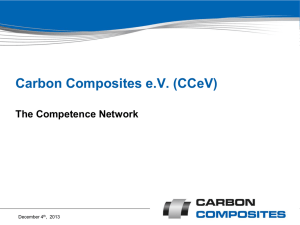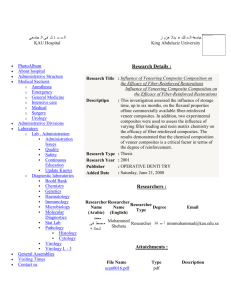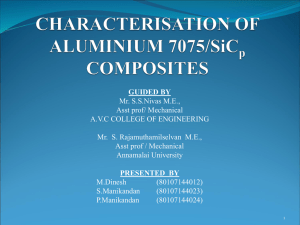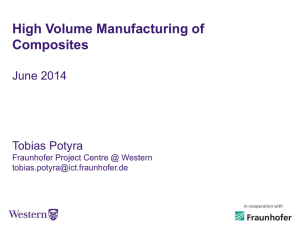The effect of alkalization and fibre alignment on the mechanical and
advertisement
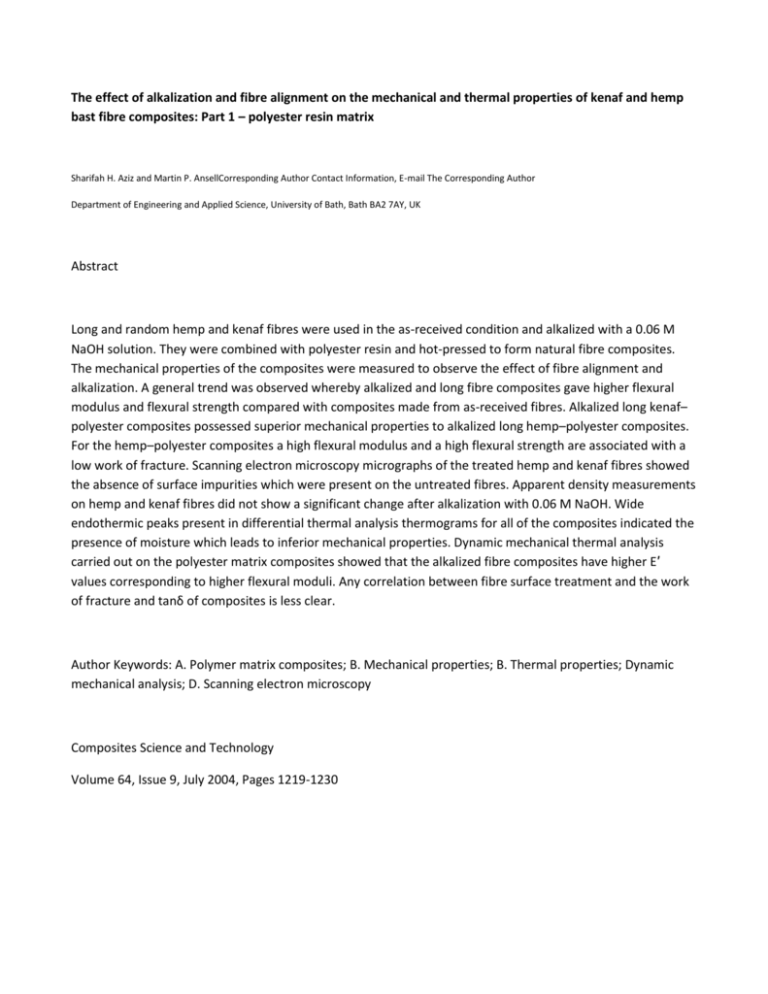
The effect of alkalization and fibre alignment on the mechanical and thermal properties of kenaf and hemp bast fibre composites: Part 1 – polyester resin matrix Sharifah H. Aziz and Martin P. AnsellCorresponding Author Contact Information, E-mail The Corresponding Author Department of Engineering and Applied Science, University of Bath, Bath BA2 7AY, UK Abstract Long and random hemp and kenaf fibres were used in the as-received condition and alkalized with a 0.06 M NaOH solution. They were combined with polyester resin and hot-pressed to form natural fibre composites. The mechanical properties of the composites were measured to observe the effect of fibre alignment and alkalization. A general trend was observed whereby alkalized and long fibre composites gave higher flexural modulus and flexural strength compared with composites made from as-received fibres. Alkalized long kenaf– polyester composites possessed superior mechanical properties to alkalized long hemp–polyester composites. For the hemp–polyester composites a high flexural modulus and a high flexural strength are associated with a low work of fracture. Scanning electron microscopy micrographs of the treated hemp and kenaf fibres showed the absence of surface impurities which were present on the untreated fibres. Apparent density measurements on hemp and kenaf fibres did not show a significant change after alkalization with 0.06 M NaOH. Wide endothermic peaks present in differential thermal analysis thermograms for all of the composites indicated the presence of moisture which leads to inferior mechanical properties. Dynamic mechanical thermal analysis carried out on the polyester matrix composites showed that the alkalized fibre composites have higher E′ values corresponding to higher flexural moduli. Any correlation between fibre surface treatment and the work of fracture and tanδ of composites is less clear. Author Keywords: A. Polymer matrix composites; B. Mechanical properties; B. Thermal properties; Dynamic mechanical analysis; D. Scanning electron microscopy Composites Science and Technology Volume 64, Issue 9, July 2004, Pages 1219-1230 Injection Molding of Postconsumer Wood–Plastic Composites II: Mechanical Properties R. Gosselin Department of Chemical Engineering, CERSIM Université Laval, Quebec City, Canada, G1K 7P4 D. Rodrigue Department of Chemical Engineering, CERSIM Université Laval, Quebec City, Canada, G1K 7P4Denis.Rodrigue@gch.ulaval.ca B. Riedl Department of Wood Sciences, CERSIM, Université Laval Quebec City, Canada, G1K 7P4 ABSTRACT: In the first part of this study, fiber-reinforced microcellular foams were produced via injection molding to study their morphological properties as a function of mold temperature as well as wood, blowing agent, and coupling agent concentrations. Yellow birch wood fibers are added to a recycled postconsumer HDPE/PP matrix (85: 15 ratio) in proportions ranging from 0 to 40 wt% and then foamed with a chemical blowing agent. Maleic-anhydride-polypropylene copolymer (MAPP) is also used as a coupling agent in proportions ranging from 0 to 10 wt% of wood content. In this second part, the mechanical properties in flexion, torsion, and traction are presented. Key Words: injection molding , composite, foam , mechanical properties , MAPP Journal of Thermoplastic Composite Materials, Vol. 19, No. 6, 659-669 (2006) Characterisation of melt-processed poly(ethylene terephthalate)/synthetic mica nanocomposite sheet and its biaxial deformation behaviour Soon, Kok H; Harkin-Jones, Eileen; Rajeev, Rajvihar S; Menary, Gary; McNally, Tony; Martin, Peter J; Armstrong, Cecil Abstract BACKGROUND: Poly(ethylene terephthalate) (PET) is widely used in the packaging industry. In order to enhance the mechanical and barrier properties, nanoscale fillers are added to PET matrices to form nanocomposites. In the work reported here, a melt-processed PET/synthetic mica nanocomposite sheet was characterised to determine the effect of the incorporation of synthetic mica on the sheet properties and also to see if these properties are an indicator of subsequent performance under high-speed, high-temperature biaxial deformation, typical of processes such as stretch blow moulding. RESULTS: The incorporation of synthetic mica was found to enhance the modulus, particularly above the glass transition temperature, and barrier properties of the extruded sheet and it significantly altered the deformation behaviour of PET under biaxial deformation. The plastic flow of PET during biaxial deformation was found to diminish for the nanocomposites, and strain hardening occurred earlier. CONCLUSION: The modulus and barrier properties of PET were enhanced by the incorporation of synthetic mica. Clay loading also altered the biaxial deformation behaviour of PET. Copyright © 2009 Society of Chemical Industry Keywords: PET nanocomposites; mechanical properties; biaxial stretching; barrier properties Polymer International, Volume 58, Number 10, October 2009 , pp. 1134-1141(8) The effect of fibre and coupling agent content on the mechanical properties of hemp/polypropylene composites Mechraoui, A.1; Riedl, B.2; Rodrigue, D.1 Abstract Composites made from hemp and polypropylene were prepared in order to determine the effect of fibre and coupling agent content on their mechanical properties. The samples were prepared by compression molding after an initial melt blending and homogenization step in an internal batch mixer. Different fibre contents (0, 10, 20 and 30 wt%) and sizes (355 and 500 μm) were used with two coupling agents: maleic anhydride polypropylene (MAPP) pellets and wax. For each case, MAPP concentrations between 0 and 7 wt% (fibre basis) were added to determine the optimum amount maximizing mechanical properties. The fractured surfaces of these composites were investigated by scanning electron microscopic technique (SEM) to investigate the fibre/matrix interfacial bonding. The mechanical properties of the composites were characterized in tensile, torsion, and flexion and the results showed that coupling agent addition has a positive effect on all moduli with an optimum content ranging between 2 and 4 wt%. It was also found that the coupling agent wax was more effective that the pellets. Keywords: POLYPROPYLENE; HEMP; MAPP; MECHANICAL PROPERTIES Composite Interfaces, Volume 14, Numbers 7-9, 2007 , pp. 837-848(12) The effect of basecoat pigmentation on mechanical properties of an automotive basecoat/clearcoat system during weathering H. Yaria, S. Moradiana, Corresponding Author Contact Information, E-mail The Corresponding Author, B. Ramazanzadea, A. Kashania and N. Tahmasebib aPolymer and Color Engineering Department, Amirkabir University of Technology, PO Box 15875-4413, Tehran, Iran bColor Engineering group, Azad University of Mahshahr, Postal Code 63519, Bander-e-Mahshahr, Khoozestan, Iran Abstract The aim of this study is to elucidate the effect of basecoat pigmentation on mechanical aspects of an automotive basecoat/clearcoat (BC/CC) system during artificial weathering exposures. A silver basecoat as the most reflective and a black basecoat as the most absorptive basecoat were selected. These two extreme behaviored basecoats were chosen with hopes that other basecoats would behave somewhere between the silver and the black extremes. The structural and mechanical properties of the coatings were investigated after various weathering exposure times (0, 150, 300, 450, 600 h). Dynamic mechanical thermal analysis (DMTA) was carried out to study variations in structure and basic characteristics of the system such as cross-linking density and Tg during weathering. In order to investigate variations in mechanical properties of the system, nano indentation, nano scratch, and tensile tests were also utilized. It was found that although both silver and black systems experienced post-curing reactions (dominant at earlier stages of weathering) and degradation reactions (dominant at later stages of weathering), but basecoat pigmentation affected the post-curing and degradation reaction rates of the BC/CC system, leading to variations in mechanical properties. It was concluded that post-curing occurred to a greater extent in the black pigmented system whilst in the silver pigmented system weathering degradation was much more sever. Keywords: Weathering; Mechanical properties; Automotive coating; Nano-indentation Polymer Degradation and Stability Volume 94, Issue 8, August 2009, Pages 1281-1289

